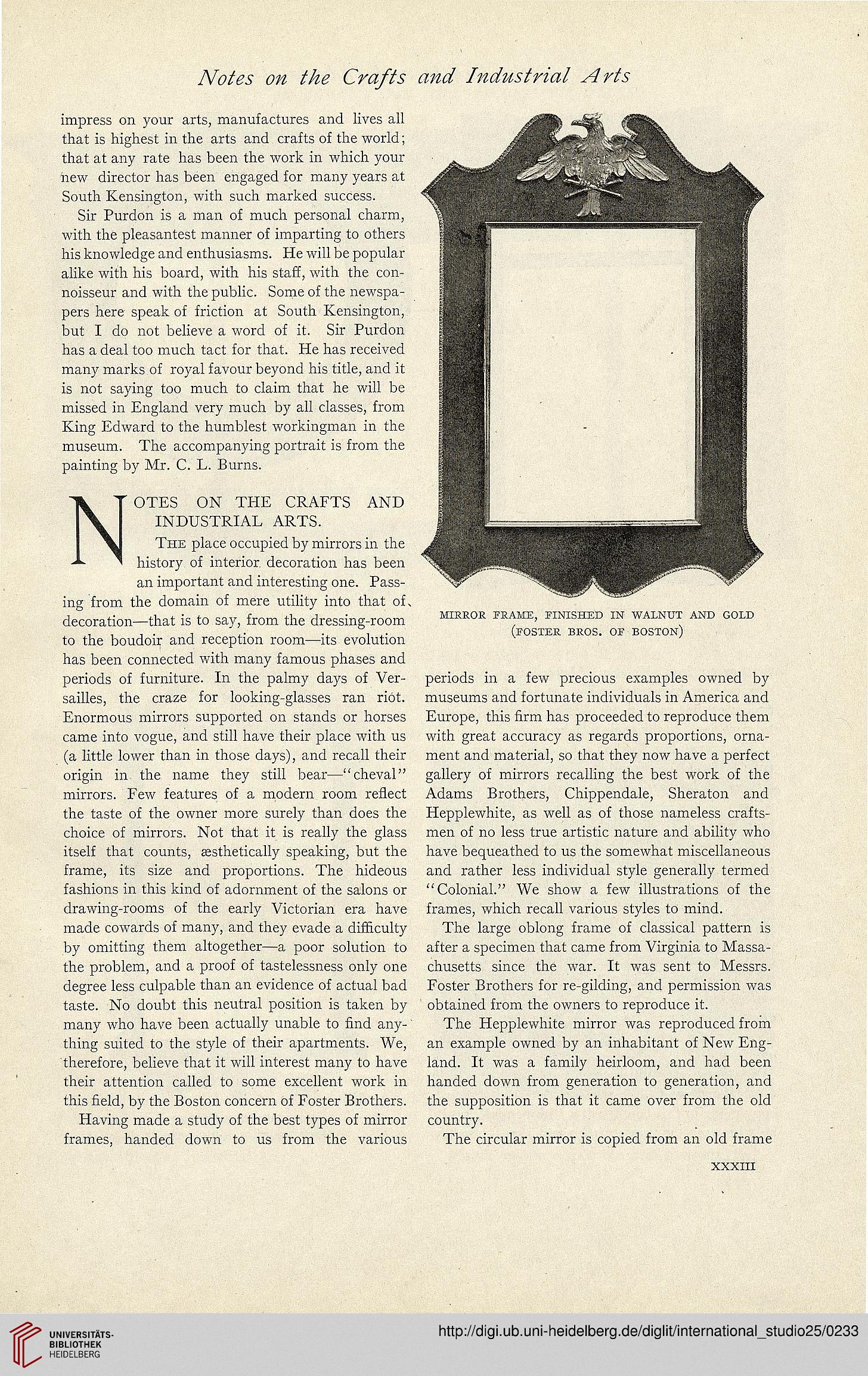impress on your arts, manufactures and lives all
that is highest in the arts and crafts of the world;
that at any rate has been the work in which your
new director has been engaged for many years at
South Kensington, with such marked success.
Sir Purdon is a man of much personal charm,
with the pleasantest manner of imparting to others
his knowledge and enthusiasms. He will be popular
alike with his board, with his staff, with the con-
noisseur and with the public. Some of the newspa-
pers here speak of friction at South Kensington,
but I do not believe a word of it. Sir Purdon
has a deal too much tact for that. He has received
many marks of royal favour beyond his title, and it
is not saying too much to claim that he will be
missed in England very much by all classes, from
King Edward to the humblest workingman in the
museum. The accompanying portrait is from the
painting by Mr. C. L. Burns.
OTES ON THE CRAFTS AND
INDUSTRIAL ARTS.
THE place occupied by mirrors in the
history of interior decoration has been
an important and interesting one. Pass-
ing from the domain of mere utility into that of.
decoration—that is to say, from the dressing-room
to the boudoir and reception room—its evolution
has been connected with many famous phases and
periods of furniture. In the palmy days of Ver-
sailles, the craze for looking-glasses ran riot.
Enormous mirrors supported on stands or horses
came into vogue, and still have their place with us
(a little lower than in those days), and recall their
origin in the name they still bear—"cheval"
mirrors. Few features of a modern room reflect
the taste of the owner more surely than does the
choice of mirrors. Not that it is really the glass
itself that counts, aesthetically speaking, but the
frame, its size and proportions. The hideous
fashions in this kind of adornment of the salons or
drawing-rooms of the early Victorian era have
made cowards of many, and they evade a difficulty
by omitting them altogether—a poor solution to
the problem, and a proof of tastelessness only one
degree less culpable than an evidence of actual bad
taste. No doubt this neutral position is taken by
many who have been actually unable to find any-
thing suited to the style of their apartments. We,
therefore, believe that it will interest many to have
their attention called to some excellent work in
this held, by the Boston concern of Foster Brothers.
Having made a study of the best types of mirror
frames, handed down to us from the various
MIRROR FRAME, FINISHED IN WALNUT AND GOLD
(FOSTER BROS. OF BOSTON)
periods in a few precious examples owned by
museums and fortunate individuals in America and
Europe, this firm has proceeded to reproduce them
with great accuracy as regards proportions, orna-
ment and material, so that they now have a perfect
gallery of mirrors recalling the best work of the
Adams Brothers, Chippendale, Sheraton and
Hepplewhite, as well as of those nameless crafts-
men of no less true artistic nature and ability who
have bequeathed to us the somewhat miscellaneous
and rather less individual style generally termed
"Colonial." We show a few illustrations of the
frames, which recall various styles to mind.
The large oblong frame of classical pattern is
after a specimen that came from Virginia to Massa-
chusetts since the war. It was sent to Messrs.
Foster Brothers for re-gilding, and permission was
obtained from the owners to reproduce it.
The Hepplewhite mirror was reproduced from
an example owned by an inhabitant of New Eng-
land. It was a family heirloom, and had been
handed down from generation to generation, and
the supposition is that it came over from the old
country.
The circular mirror is copied from an old frame
XXXIII




